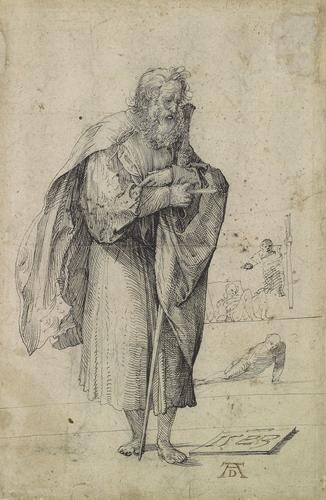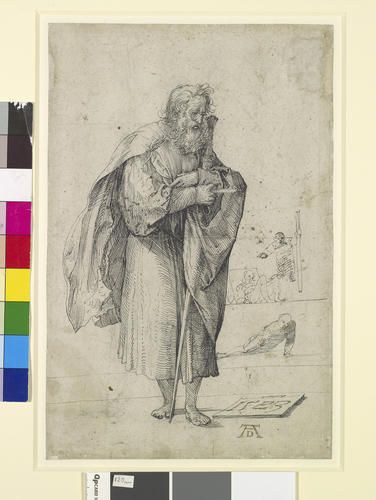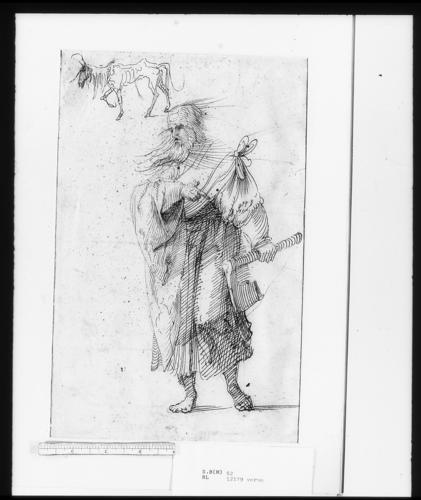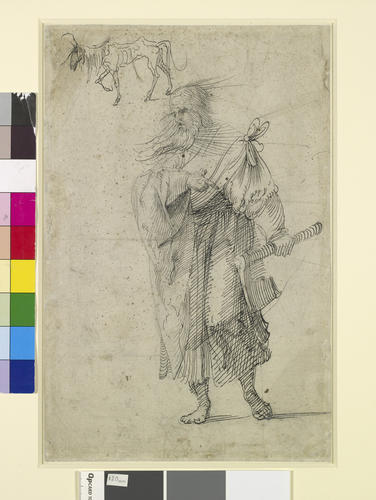Recto: St Paul standing and holding a sword. Verso: St Matthias with an axe 1523
Pen and black ink | 29.6 x 19.4 cm (sheet of paper) | RCIN 912179

Hans Schäufelein (1482/3-c. 1540)
Recto: St Paul standing and holding a sword. Verso: St Matthias with an axe 1523

Hans Schäufelein (1482/3-c. 1540)
Recto: St Paul standing and holding a sword. Verso: St Matthias with an axe 1523

Hans Schäufelein (1482/3-c. 1540)
Recto: St Paul standing and holding a sword. Verso: St Matthias with an axe 1523

Hans Schäufelein (1482/3-c. 1540)
Recto: St Paul standing and holding a sword. Verso: St Matthias with an axe 1523





-
Recto: a drawing of St Paul, standing full length, with his arms around the hilt of sword; with sketches of three smaller figures on the right; with a fictive plaque bearing the date, 1523, at the saint's feet above an AD monogram. Verso: a drawing of St Matthias holding an axe, with a sketch of an emaciated horse above.
Hans Schäufelein, whose place of birth is unknown, is first recorded as a mature artist working with Albrecht Dürer. He seems to have joined Dürer's workshop c.1503, at the same time as his contemporary Hans Baldung Grien. In around 1508 he was working in the studio of Hans Holbein the Elder, where he would presumably have met the painter's son Hans, then around 10 years old. In 1515 Schäufelein settled in Nordlingen, south-west of Nuremberg, where he was based until his death.
The figure of St Paul has not been related to any surviving project, but a series of similar figures by Schäufelein in Leipzig, dating from c.1507-9 were used by an associate of the artist for the saints on an altarpiece in Engerda near Erfurt. Single figures of saints were a staple of late medieval European art, appearing in textiles, stained glass, frescoes, manuscripts and prints, as well as paintings, and Schäufelein may well have prepared the St Paul figure in response to an unrecorded commission. That the drawing was a study, rather than a finished drawing, is also suggested by the brief studies to the right of the sheet, which show two reclining figures, and a third balancing with the aid of a pole.
The verso of the St Paul drawing bears another figure, of St Matthias, holding the axe which was sometimes thought to be the instrument of his martyrdom. The attribution of this drawing has been questioned, but it is in fact an improvisation on the outlines of St Paul, which have in part been traced through from the other side of the sheet (the tracing occurs particularly down the left-hand side of St Matthias, and in his right shoulder). It probably represents a dashed-off exercise rather than a carefully thought-out study. The striking image of an emaciated horse at the top left is a similarly impressive demonstration of Schäufelein's ability to capture an appearance in a quick sketch.
Nearly one hundred drawings are attributed to Schäufelein. The majority of these are, like the present example, in pen and ink, although Schäufelein sometimes used black chalk in portrait and figure studies. An AD monogram has been added to the sheet: such monograms, claiming Dürer's authorship, were often added to drawings by later collectors. Schäufelein's drawings clearly show the influence of his time in Dürer's workshop, and a number of his early drawings are copies of works by Dürer.
Catalogue entry adapted from The Northern Renaissance. Dürer to Holbein, London 2011Provenance
First recorded in a Royal Collection inventory of c.1800-1820 (Inv.A, p.14: 'Albert Durer e Maestri Antichi Divsi.')
-
Medium and techniques
Pen and black ink
Measurements
29.6 x 19.4 cm (sheet of paper)
29.4 x 19.2 cm (sight)
Object type(s)
Other number(s)
RL 12179








